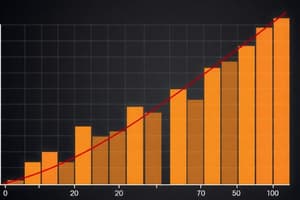Podcast
Questions and Answers
In regression analysis, what term describes a variable whose value is influenced or predicted?
In regression analysis, what term describes a variable whose value is influenced or predicted?
- Explanatory variable
- Independent variable
- Regressor variable
- Dependent variable (correct)
Which principle is used to obtain the line of regression that gives the 'best fit' estimate?
Which principle is used to obtain the line of regression that gives the 'best fit' estimate?
- Central Limit Theorem
- Bayesian Inference
- Principle of Least Squares (correct)
- Principle of Maximum Likelihood
If a curve in a bivariate distribution is not a straight line, how is the regression described?
If a curve in a bivariate distribution is not a straight line, how is the regression described?
- Curvilinear (correct)
- Multilinear
- Linear
- Rectilinear
What do the 'normal equations' in the context of least squares estimation help to determine?
What do the 'normal equations' in the context of least squares estimation help to determine?
In the equation of the regression line of Y on X, $Y = a + bX$, what does 'b' represent?
In the equation of the regression line of Y on X, $Y = a + bX$, what does 'b' represent?
If the regression line of Y on X passes through the point $(\bar{x}, \bar{y})$, what does this indicate?
If the regression line of Y on X passes through the point $(\bar{x}, \bar{y})$, what does this indicate?
What does $\mu_{11}$ represent in the context of regression analysis?
What does $\mu_{11}$ represent in the context of regression analysis?
Given the equation $\mu_{11} = b \sigma_x^2$, where $\mu_{11}$ is the covariance and $\sigma_x^2$ is the variance of X, what does 'b' represent?
Given the equation $\mu_{11} = b \sigma_x^2$, where $\mu_{11}$ is the covariance and $\sigma_x^2$ is the variance of X, what does 'b' represent?
What is the geometric mean between the regression coefficients equal to?
What is the geometric mean between the regression coefficients equal to?
If one of the regression coefficients is greater than unity, what must be true of the other regression coefficient?
If one of the regression coefficients is greater than unity, what must be true of the other regression coefficient?
What aspect of the data does NOT affect regression coefficients?
What aspect of the data does NOT affect regression coefficients?
If two variables are uncorrelated, what is the angle between the two lines of regression?
If two variables are uncorrelated, what is the angle between the two lines of regression?
Under which condition do the two lines of regression coincide?
Under which condition do the two lines of regression coincide?
What does the regression coefficient of Y on X represent?
What does the regression coefficient of Y on X represent?
How are the regression equations used to predict X for any given value of Y?
How are the regression equations used to predict X for any given value of Y?
If in a partially destroyed laboratory, the variance of $X$ is 9 and given regression equations are $8X - 10Y + 66 = 0$ and $40X - 18Y = 214$, what is the value of $\bar{X}$?
If in a partially destroyed laboratory, the variance of $X$ is 9 and given regression equations are $8X - 10Y + 66 = 0$ and $40X - 18Y = 214$, what is the value of $\bar{X}$?
Still using the information in the last question, what is the value of $\bar{Y}$?
Still using the information in the last question, what is the value of $\bar{Y}$?
Compute the correlation coefficient $r$ from the partially destroyed lab, again using: variance of $X$ is 9 and given regression equations are $8X - 10Y + 66 = 0$ and $40X - 18Y = 214$.
Compute the correlation coefficient $r$ from the partially destroyed lab, again using: variance of $X$ is 9 and given regression equations are $8X - 10Y + 66 = 0$ and $40X - 18Y = 214$.
Again, using variance of $X$ is 9 and given regression equations are $8X - 10Y + 66 = 0$ and $40X - 18Y = 214$, what is the standard deviation of $Y$?
Again, using variance of $X$ is 9 and given regression equations are $8X - 10Y + 66 = 0$ and $40X - 18Y = 214$, what is the standard deviation of $Y$?
If the average price and standard deviation for Kolkata are 65 and 2.5 respectively, and for Mumbai are 67 and 3.5 respectively, with a correlation of 0.8, what is the predicted price in Mumbai corresponding to a price of 70 in Kolkata?
If the average price and standard deviation for Kolkata are 65 and 2.5 respectively, and for Mumbai are 67 and 3.5 respectively, with a correlation of 0.8, what is the predicted price in Mumbai corresponding to a price of 70 in Kolkata?
Flashcards
Regression Analysis
Regression Analysis
Mathematical measure of the average relationship between two or more variables.
Dependent Variable
Dependent Variable
The variable whose value is influenced or predicted in regression analysis.
Independent Variable
Independent Variable
The variable used for prediction in regression analysis.
Independent Variable (Synonyms)
Independent Variable (Synonyms)
Signup and view all the flashcards
Dependent Variable (Synonyms)
Dependent Variable (Synonyms)
Signup and view all the flashcards
Curve of Regression
Curve of Regression
Signup and view all the flashcards
Line of Regression
Line of Regression
Signup and view all the flashcards
Line of Regression (Best Fit)
Line of Regression (Best Fit)
Signup and view all the flashcards
Line of Regression Equation
Line of Regression Equation
Signup and view all the flashcards
Two Lines of Regression
Two Lines of Regression
Signup and view all the flashcards
Regression Lines and Perfect Correlation
Regression Lines and Perfect Correlation
Signup and view all the flashcards
Relevance of 'b' in regression
Relevance of 'b' in regression
Signup and view all the flashcards
Correlation Coefficient
Correlation Coefficient
Signup and view all the flashcards
If One Regression Coefficient...
If One Regression Coefficient...
Signup and view all the flashcards
Regression Coefficients' Independence
Regression Coefficients' Independence
Signup and view all the flashcards
Study Notes
Regression Analysis
- Mathematical measure of the average relationship between two or more variables
- Relationship is described relative to the original units of data
Types of Variables
- Dependent variable: Value is influenced/predicted
- Independent variable: Used for prediction
Variable Terminology
- Independent variable is also called regressor, predictor, or explanatory variable
- Dependent variable is also called regressed or explained variable
Lines of Regression
- In a bivariate distribution, points in the scatter diagram cluster around "curve of regression"
- Straight line curve is called the "line of regression"
- Referred to as linear regression between the variables
- Otherwise, the regression is curvilinear
- Line gives best estimate to the value of one variable for a specific value of the other variable
- Line which gives the best estimate to the "centre of best fit"
- Can be obtained by the principle of least squares
Line of Regression Equation
- Line of regression of Y on X: Y = a + bx
- Normal equations for estimating a and b
- Σyi = na + bΣxi
- Σxiyi = aΣxi + bΣxi^2
- Dividing the first normal equation by n results in ȳ = a + bx̄
- Regression line of Y on X passes through the point (x̄, ȳ)
Covariance and Correlation
- Cov(X,Y) = (1/n) * Σxiyi - x̄ȳ = μ11
- μ11 = (1/n) * Σxiyi - x̄ȳ = μ11 + x̄ȳ
- σx^2 = (1/n) * Σxi^2 - x̄^2
- (1/n) * Σxi^2 = σx^2 + x̄^2
- After multiplying and subtracting: μ11 = bσx^2
- Solving for b: b = μ11 / σx^2
Regression Line Slope
- b is the slope of the line of regression of Y on X
- The regression line equation: Y - ȳ = b(X - x̄)
- Rewriting the regression line equation: Y - ȳ = (μ11 / σx^2)(X - x̄)
Standard Deviations
- Y - ȳ = r(σy / σx)(X - x̄)
- r = μ11 / σxσy
- Regression equation for X on Y: X - x̄ = r(σx / σy)(Y - ȳ)
Two Lines of Regression
- There are always two lines of regression
- One of Y on X and the other of X on Y.
- Line of regression of Y on X is used to predict/estimate values of Y for any given value of X in the data
- Y is a dependent variable and X is independent
- To estimate/predict X for any given value of Y, we use the regression equation of X on Y
- Minimizes sum of squares of error of estimates in X
- X is a dependent variable and Y is independent
Correlation
- Perfect correlation (positive or negative), equation of the line of regression of Y on X becomes Y - ȳ = ± (σy / σx)(X - x̄)
- This simplifies to Y - ȳ / σy = ± (X - x̄) / σx
- Perfect correlation (positive or negative), the equation of the line of regression of X on Y: X - x̄ = ± (σx / σy)(Y - ȳ)
- Simplifies to: X - x̄ / σx = ± (Y - ȳ) / σy
- In cases of perfect correlation (r = ±1), both lines of regression coincide
- Two lines of regression exist, except in perfect correlation where they coincide into one line.
Regression Coefficients
- Slope 'b' of the regression line of Y on X is called the "regression coefficient" of Y on X
- Represents the increment in the value of the dependent variable Y for each unit change in the independent variable X
- Regression coefficient of Y on X: byx = μ11 / σx^2 = r σy / σx
- Regression coefficient of X on Y: bxy = μ11 / σy^2 = r σx / σy
Properties of Regression Coefficients
- Correlation coefficient (r) is the geometric mean between the regression coefficients
- bxy = r σx / σy and byx = r σy / σx
- Therefore, r = ± √(bxy * byx)
- If one regression coefficient is greater than unity, the other must be less than unity
- Regression coefficients are independent of changes of origin, but not of scale
Angle Between Regression Lines
- If θ is the angle between the two lines of regression
- tan θ = | (1 - r^2) / r | / (σx σy / (σx^2 + σy^2))
- If r = 0, then tan θ = ∞, θ = π/2
- Uncorrelated variables, then regression lines become perpendicular
Angle: Perfect Correlation
- If r = ±1, then tan θ = 0, θ = 0 or π
- Two lines of regression either coincide or are parallel
- If they pass through the same point, they cannot be parallel, they must coincide
- In a case of perfect correlation (positive or negative), the two lines of regression coincide
Studying That Suits You
Use AI to generate personalized quizzes and flashcards to suit your learning preferences.



